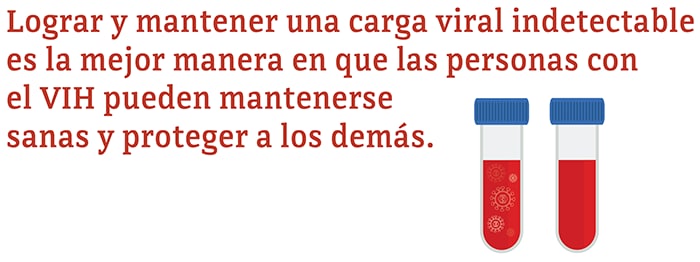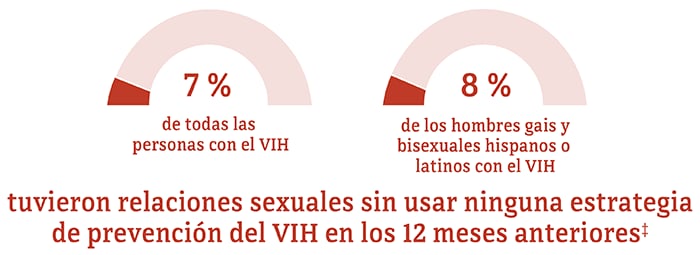El VIH y los hombres gais y bisexuales hispanos o latinos: Comportamientos de riesgo
El riesgo de contraer o transmitir el VIH varía ampliamente según el tipo de exposición o comportamiento y hay muchos factores que pueden aumentarlo o reducirlo. Por lo general, las personas que contraen o transmiten el VIH lo hacen por medio de las relaciones sexuales anales o vaginales, o al compartir agujas, jeringas u otros implementos para la inyección de drogas como, por ejemplo, los calentadores.
Comportamientos sexuales entre los hombres gais y bisexuales hispanos o latinos con diagnóstico de infección por el VIH en los EE. UU., 2019*†


* Las personas hispanas o latinas pueden ser de cualquier raza.
† Entre las personas de 18 años de edad o más.
‡ Tuvieron relaciones sexuales sin tener supresión viral y sin usar condón con una pareja que no tenía o no sabía si tenía el VIH y no estaba tomando la PrEP.
Fuente: CDC. Medical Monitoring Project.
- CDC. Diagnoses of HIV infection in the United States and dependent areas, 2019. HIV Surveillance Report 2021;32.
- CDC. Estimated HIV incidence and prevalence in the United States, 2015–2019. HIV Surveillance Supplemental Report 2021;26(1).
- CDC. Monitoring selected national HIV prevention and care objectives by using HIV surveillance data—United States and 6 dependent areas, 2019. HIV Surveillance Supplemental Report 2021;26(2).
- CDC. Barriers to antiretroviral therapy adherence among HIV-positive Hispanic and Latino men who have sex with men—United States, 2015–2019. MMWR 2020;69(40):1437-42.
- CDC. HIV infection risk, prevention, and testing behaviors among men who have sex with men—National HIV Behavioral Surveillance, 23 U.S. cities, 2017. HIV Surveillance Special Report 2019;22.
- CDC. HIV care outcomes among men who have sex with men with diagnosed HIV infection—United States, 2015. MMWR 2017;66(37):969-74.
- Crepaz N, Mullins M, Higa D, Gunn J, Salabarría-Peña Y. A rapid review of disparities in HIV prevention and care outcomes among Hispanic/Latino men who have sex with men in the United States. AIDS Educ Prev 2021; 33(4):276-89. PubMed abstract.
- McCree DH, Walker T, DiNenno E, et al. A programmatic approach to address increasing HIV diagnoses among Hispanic/Latino MSM, 2010-2014. Prev Med 2018;114:64-71. PubMed abstract.
Vea esta Página en: El VIH y los hombres gais y bisexuales hispanos o latinos hojas informativa
Esta página fue revisada: el 28 de abril del 2022